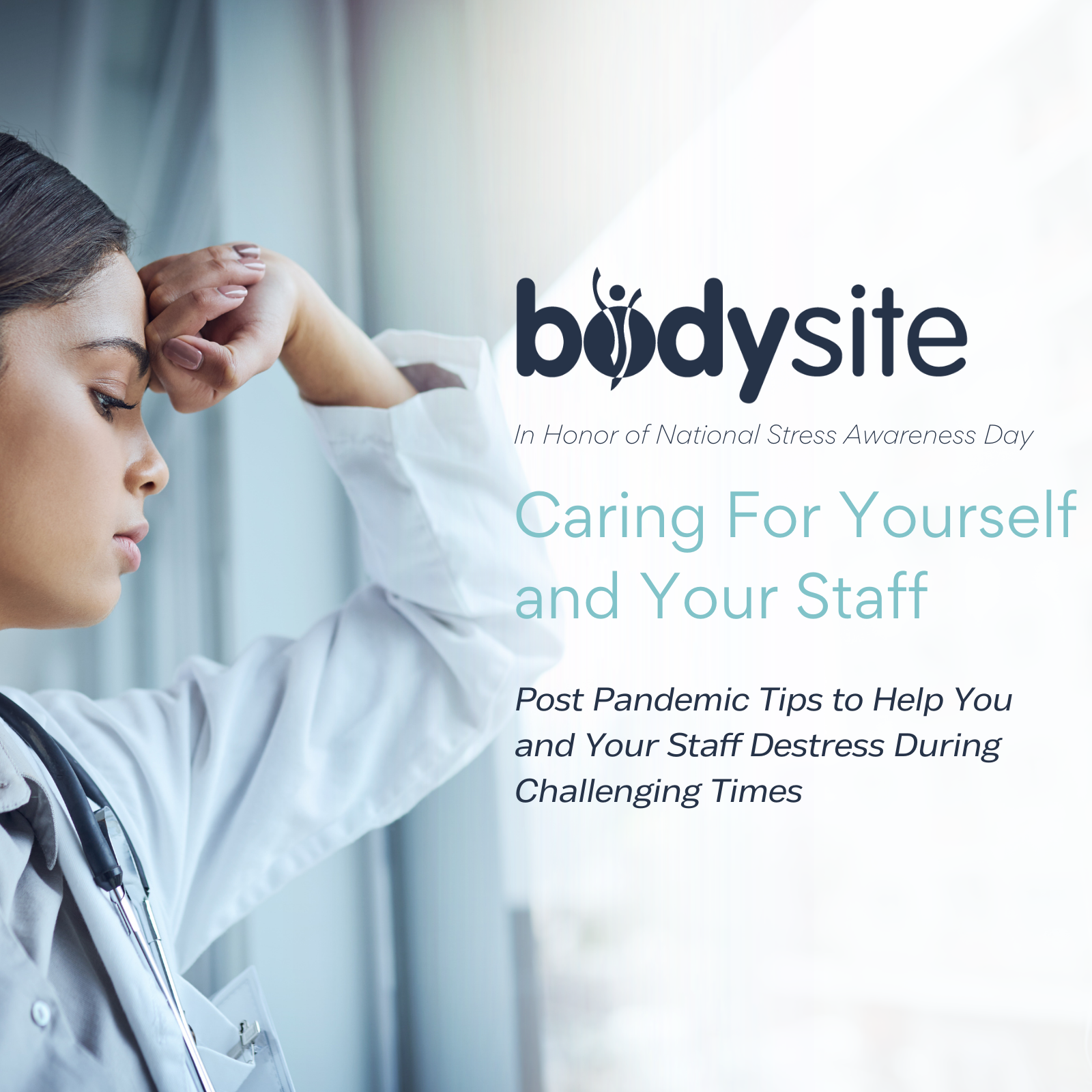Caring For Yourself and Your Staff: National Stress Awareness Day

As we move towards a post pandemic world, things still aren’t easy and there’s certainly no rulebook on how to move forward.
If you and your staff have been feeling overwhelmed by the recent pandemic, and you’re still recovering from the emotional toll, you’re not alone. In honor of National Stress Awareness Day, we wanted to shift the focus to an extremely important and often overlooked group of individuals: healthcare workers.
According to a study conducted of healthcare workers in August of 2022, regardless of job title and level of direct involvement with COVID-patients:
- 91% report regularly feeling stress
- 83% report anxiety
- 81% report exhaustion/burnout
- 77% report feeling overwhelmed [1]
Although providers are no longer confronting the initial challenges of the pandemic, recovering and adapting to this is clearly still an uphill battle. The mental health challenges following COVID have created what seems like another epidemic altogether. This is why it’s important to create strategies to help you and your staff with your mental health in the long run.
Here are ways you can improve the burdens of work for yourself and your employees. . .
Create A Relaxing Environment
While it may not be possible in all office or hospital environments, consider setting up a designated quiet space for staff members who need a breather. Knowing that your staff can have not only adequate breaks but re-energizing breaks is a great way to promote relaxation amidst the chaos of everyday stressors.
This space can be designated anywhere in your office, it could be a spare room, corner, break room, etc.
One example is Saint Michael’s Medical Center in Newark. They recently incorporated a “Zen Room, a darkened space with relaxing sounds, soothing smells and comfortable furniture that employees can access any time they feel the need.” [2]
‘We want to give employees the opportunity to pull themselves away from their areas, sit down and reflect, get themselves in a better mental state of mind and then be able to go back to work and contribute in a positive and efficient way,” said Sue Bruno, the director of human resources at Saint Michael’s Medical Center’.” [2]
This new space is a great place for providers to recharge before during and after stressful works days and can help to make work a safe and comfortable environment even during the most challenging days.

Open and Honest Conversations
Create an open door policy for your employees to discuss mental health at the office. While no one has to share any details about their mental health or struggles unless they are comfortable, it could greatly benefit your staff to have a safe space to discuss how they’re feeling and how they can be better supported, without fear of repercussions.
Additionally, consider bringing in a mental health speaker or another relevant professional to your office to discuss broad issues and solutions with your staff.
Having these conversations is a great way to tackle issues head on. The alternative is letting these issues bottle up and in turn, your employees may leave, continue to be unhappy and also be unproductive.
Evaluating Staff Benefits and Culture
If your staff has been especially stressed recently or you find turnover to be a continual issue, you may want to re-evaluate your benefits package and the perks of working with your office or organization.
While certain benefits may have been enough for employees to feel fairly compensated in the past, with recent inflation, and COVID-related burnout, your staff may need additional support. This may mean increased time off, or even raises.
However, if your employees are already well compensated or if your organization can’t make changes to traditional benefits, think outside of the box.
Sometimes making changes to company culture can be a powerful tool for improving employee morale and reducing stress. A few ways to change the company culture include…
- Encouraging a positive atmosphere throughout daily interactions
- Monthly awards and recognition and promoting an environment of helping one another
- Having monthly or weekly celebrations
If you can’t afford to make monetary changes, a smile, a helping hand and a concerted effort can make a world of difference.
Taking Care of Yourself
Whether you’re the owner of your practice or a brand new hire without the ability to enact great change in your workplace, you are always in control of your personal and mental health journey.
Take time to care for your health both physically and emotionally and if needed, seek the help of a professional if needed. Sometimes it only takes one person to make a difference in the morale and well-being of a workplace.
Automation
Working smarter, not harder through automation is one of the most effective ways to reduce stress at your office. In 2022, there is no reason for multiple individuals to be doing a job that could be automated. An example of this is technology is automated patient education.
If you find that patient’s are constantly calling in about their care, asking questions or scheduling redundant visits, this can overwhelm the staff, placing them on a care plan pre-equipped with digital instructions, resources and tracking could be an excellent way of freeing up staff time and resources.
If you’re browsing tools that can automate your patient interactions and help automate staff tasks, check out the BodySite remote patient care solution. BodySite offers a 30 Day Free Trial to new or returning providers with no obligation, here: https://bodysite.com/start-a-free-trial/.
SOURCES:
- “The Mental Health of Healthcare Workers.” Mental Health America, 5 Aug. 2022, https://mhanational.org/research-reports/healthcare-workers.
- Office, Saint Michael’s Press, and Elizabeth Llorente | NJ Advance Media for NJ.com. “A Room for Quiet Contemplation in a Busy Hospital.” Saint Michael’s Medical Center, 9 Aug. 2021, https://www.smmcnj.com/news/2021/august/a-room-for-quiet-contemplation-amid-the-hustle-a/.
